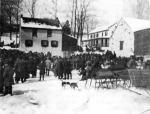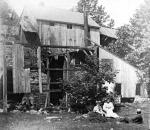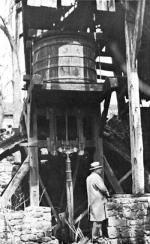![header=[Marker Text] body=[Hopewell Forge, 1744, and Furnace, 1770, were seven miles south. The furnace and the remains of an iron making community of the era are administered by the National Park Service, with recreation areas. ] sign](http://explorepahistory.com/kora/files/1/10/1-A-2B2-139-ExplorePAHistory-a0k1z2-a_450.jpg)
Mouse over for marker text
Name:
Hopewell Village [Iron]
Region:
Hershey/Gettysburg/Dutch Country Region
County:
Berks
Marker Location:
U.S. 422 east and westbound at Pa. 82, Baumstown
Dedication Date:
March 29, 1947
Behind the Marker
Hopewell Village was based on a foundation of complex relationships between ironmasters and workers. The heart of this village was the charcoal-iron furnace, erected probably in 1771. Initially, successive owners, saddled with debt and legal challenges, barely kept the furnace operating. Indeed, from 1808 to 1816 the furnace was out of blast. After 1816, however, ironmaster Clement Brooke led the plantation to sustained profitability. He typically employed more than 200 workers during the 1820s and 1830s. Skilled and unskilled employees–white and black, including men, women and children–comprised the varied workforce that made cast-iron stoves and pig iron. Their labor, Brooke's leadership, and stable labor relations were critical to the profitable operation of the plantation.
Men were the majority of employees, coming primarily from neighboring farms. Ironmasters employed craftsmen as needed, including blacksmiths, masons, carpenters, wheelwrights, and shoemakers. Skilled workers migrated from other southeastern Pennsylvania iron works, or they handed their jobs down from father to son at Hopewell Village. Men labored cutting wood, making charcoal, mining ore, operating the furnace, and driving teams around the plantation. Woodcutters were the most numerous employees, forming about half the workforce. They chopped 4,000 cords of wood per year on furnace land (the furnace bought another 3,000 cords annually).
another 3,000 cords annually).
Blacks and apprentices were important groups within the village workforce. Most blacks filled the lowest paid and least-skilled jobs. Some blacks worked skilled jobs, such as Joab Lee, who was a filler at the furnace from 1806 to 1809. There was a rough equality in certain respects. Blacks received the same wages as whites in the same jobs and lived among white neighbors in the village, and black children went to school with white children. Many black families, as well as some white households, also apprenticed children for years of service to the ironmaster. Nevertheless, most whites in the village, like most whites in Pennsylvania, probably considered blacks racially inferior.
A saying succinctly stated the position of women in the village: Hopewell "was heaven for horses but hell for women." In other words, men cared for horses but women had to fend for themselves and their families. Women cared for their homes and children. They also supplemented family income by boarding employees, working on plantation farms, and growing and cooking food, sewing, and washing clothes for others. A few women worked in the traditionally male jobs of mining ore, cutting wood, and casting iron.
Many parents put their children to work on the plantation to help support their families. Boys worked as guttermen, stocked charcoal at the furnace, mined or loaded ore, and worked on farms. Girls had fewer alternatives, such as serving as maids or housekeepers at the ironmaster's mansion or working on plantation farms. Regardless of occupation, girls and boys worked from an early age to contribute to the household.
Workers and ironmasters maintained complex relationships with each other. The ironmaster was the paternalistic manager of the furnace and village. He bought land and raw materials, decided what work was to be done by whom, and marketed the products. He depended on his employees to do their jobs well, particularly skilled workers who were often in short supply. He oversaw the plantation store that sold goods to workers. He entertained workers' families in his mansion.
Brooke, ironmaster between 1816 and 1848, hired tutors to educate younger children in the village, and then erected a public school building in 1836. Brooke and other managers also disciplined workers in order to enforce steady and satisfactory work. Employees lost pay if they did not come to work, and they were fined for poor work or negligence. Thomas Johnson, for example, was fined one dollar "for neglecting sending 1 load coal in was lying Drunk in ye Cabin." Workers were also fined for bringing whiskey on the job. Although it was rare, ironmasters fired workers for unsatisfactory work, such as the laborers who washed ore but "do not deliver ore Clear of Sand...."
Workers depended on ironmasters and each other at Hopewell Village. They depended on ironmasters to make profitable decisions about manufacturing and marketing products, since financial losses could shut down the furnace and force employees out of work. Some workers deferred to and respected the ironmaster, including seeking his legal and medical advice. But employees also acted contrary to the ironmaster's desires with absenteeism, drunkenness, negligence, and theft of furnace property. In 1838 workers at one of Hopewell's mines went to the unusual length of striking.
Brooke managed the workers and furnace of Hopewell Village until 1848, when he retired. After his tenure, the plantation faced mounting competition from anthracite-coal and bituminous-coke furnaces. The furnace went out of blast for the last time in 1883, and the village entered a long period of deterioration. The surviving structures began a new chapter of life in 1935, when the National Park Service purchased part of the remaining plantation, creating one of the nation's finest examples of a nineteenth-century iron plantation.
Men were the majority of employees, coming primarily from neighboring farms. Ironmasters employed craftsmen as needed, including blacksmiths, masons, carpenters, wheelwrights, and shoemakers. Skilled workers migrated from other southeastern Pennsylvania iron works, or they handed their jobs down from father to son at Hopewell Village. Men labored cutting wood, making charcoal, mining ore, operating the furnace, and driving teams around the plantation. Woodcutters were the most numerous employees, forming about half the workforce. They chopped 4,000 cords of wood per year on furnace land (the furnace bought
Blacks and apprentices were important groups within the village workforce. Most blacks filled the lowest paid and least-skilled jobs. Some blacks worked skilled jobs, such as Joab Lee, who was a filler at the furnace from 1806 to 1809. There was a rough equality in certain respects. Blacks received the same wages as whites in the same jobs and lived among white neighbors in the village, and black children went to school with white children. Many black families, as well as some white households, also apprenticed children for years of service to the ironmaster. Nevertheless, most whites in the village, like most whites in Pennsylvania, probably considered blacks racially inferior.
A saying succinctly stated the position of women in the village: Hopewell "was heaven for horses but hell for women." In other words, men cared for horses but women had to fend for themselves and their families. Women cared for their homes and children. They also supplemented family income by boarding employees, working on plantation farms, and growing and cooking food, sewing, and washing clothes for others. A few women worked in the traditionally male jobs of mining ore, cutting wood, and casting iron.
Many parents put their children to work on the plantation to help support their families. Boys worked as guttermen, stocked charcoal at the furnace, mined or loaded ore, and worked on farms. Girls had fewer alternatives, such as serving as maids or housekeepers at the ironmaster's mansion or working on plantation farms. Regardless of occupation, girls and boys worked from an early age to contribute to the household.
Workers and ironmasters maintained complex relationships with each other. The ironmaster was the paternalistic manager of the furnace and village. He bought land and raw materials, decided what work was to be done by whom, and marketed the products. He depended on his employees to do their jobs well, particularly skilled workers who were often in short supply. He oversaw the plantation store that sold goods to workers. He entertained workers' families in his mansion.
Brooke, ironmaster between 1816 and 1848, hired tutors to educate younger children in the village, and then erected a public school building in 1836. Brooke and other managers also disciplined workers in order to enforce steady and satisfactory work. Employees lost pay if they did not come to work, and they were fined for poor work or negligence. Thomas Johnson, for example, was fined one dollar "for neglecting sending 1 load coal in was lying Drunk in ye Cabin." Workers were also fined for bringing whiskey on the job. Although it was rare, ironmasters fired workers for unsatisfactory work, such as the laborers who washed ore but "do not deliver ore Clear of Sand...."
Workers depended on ironmasters and each other at Hopewell Village. They depended on ironmasters to make profitable decisions about manufacturing and marketing products, since financial losses could shut down the furnace and force employees out of work. Some workers deferred to and respected the ironmaster, including seeking his legal and medical advice. But employees also acted contrary to the ironmaster's desires with absenteeism, drunkenness, negligence, and theft of furnace property. In 1838 workers at one of Hopewell's mines went to the unusual length of striking.
Brooke managed the workers and furnace of Hopewell Village until 1848, when he retired. After his tenure, the plantation faced mounting competition from anthracite-coal and bituminous-coke furnaces. The furnace went out of blast for the last time in 1883, and the village entered a long period of deterioration. The surviving structures began a new chapter of life in 1935, when the National Park Service purchased part of the remaining plantation, creating one of the nation's finest examples of a nineteenth-century iron plantation.










